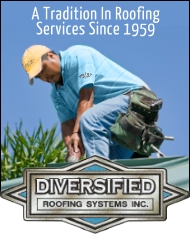Roofing Systems
Diversified Roofing Systems offers many roofing system options for your particular need. Below you will find our most popular option. We will inspect your roof and recommend the best solution free of charge, just fill out this Free Site Evaluation.![]()
Metal Roofing
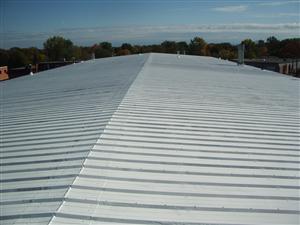 Metal roofing last longer, stands up to the elements and is better for the environment. You will find that your new metal roof provides incredible benefits.
Metal roofing last longer, stands up to the elements and is better for the environment. You will find that your new metal roof provides incredible benefits.
This structure was built using a metal frame and incorporates our steel roofing. Really, there are few limits to what you can do with metal.
Every single day the roof of a building receives the brunt of the elements. Every day it is subjected to one or more of the following: wind, rain, snow and a direct bombardment of UV rays. It stands to reason that the investment you make in your roof protects the entire investment of your property. A metal roof is the surest way to secure the investment you’ve made in your property because it outperforms any other roofing material.
![]()
EPDM (Ethylene Propylene Diene Monomer a.k.a. Rubber)
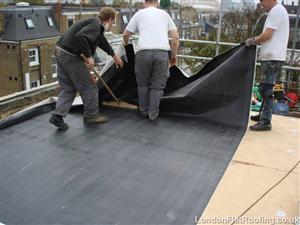 With it’s extreme flexibility and durability, EPDM is the ideal covering for all kinds of roofs – including valleys, dormer roofs, outbuildings and even damp-proofing warehouses.
With it’s extreme flexibility and durability, EPDM is the ideal covering for all kinds of roofs – including valleys, dormer roofs, outbuildings and even damp-proofing warehouses.
EPDM is also UV and ozone stable so it never perishes. It stays flexible and can move with your building unlike static installation systems.
EPDM also has very low maintenance costs. It can be used in very cold and hot climates – EPDM has been installed successfully in Alaska and in Florida. So weather is never a problem!
![]()
TPO (Thermoplastic Olefin)
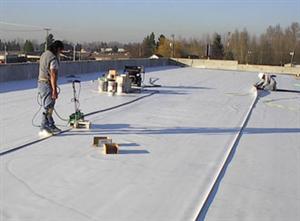 TPO membranes are single-ply roof membranes constructed from ethylene propylene rubber. They are designed to combine the durability of rubber with the proven performance of hot-air weldable seams. They have been tested as having excellent resistance to ozone, are algae-resistant, environmentally friendly and safe to install. The material’s manufacturers are so confident in properly welded seams that the material is sometimes advertised as a monolithic (seamless) roof. Seam strengths are reportedly 3 to 4 times those of EPDM’s adhesive and tape seams.
TPO membranes are single-ply roof membranes constructed from ethylene propylene rubber. They are designed to combine the durability of rubber with the proven performance of hot-air weldable seams. They have been tested as having excellent resistance to ozone, are algae-resistant, environmentally friendly and safe to install. The material’s manufacturers are so confident in properly welded seams that the material is sometimes advertised as a monolithic (seamless) roof. Seam strengths are reportedly 3 to 4 times those of EPDM’s adhesive and tape seams.
TPO is highly resistant to tears, impacts, and punctures with good flexibility to allow for building movement. TPO’s are available in white, light gray, and black with thicknesses of either 45 mils (.045″) or 60 mils (.060″). The width of the membrane depends on the manufacturer but they usually come in widths of six to six-and-a-half feet and are one-hundred feet in length.
![]()
PVC (Polyvinyl Chloride)
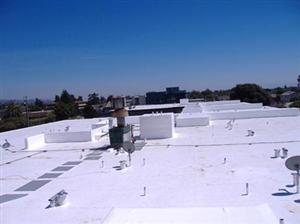 The PVC roofing membrane is made by a process of heat welding seam technology, which not only allows for one single piece of PVC roofing to cover an entire roof’s surface and eliminate seams and joints, but also provides excellent flexibility. This makes PVC roofing applicable to practically any shaped surface, and makes the installation process quick and simple. The material itself is extremely durable, and has a high resistance to punctures and impact, as well as fire propagation and flame exposure resistance. PVC roofing also has good tolerance for thermal movement because of its flexibility, and is exceptionally tough against contamination and rooftop soiling. Additionally, PVC roofing is virtually maintenance free, as it is both waterproof and dirt resistant. Usually woven with fabrics such as glass fibre and polyester, the PVC roofing membrane can provide up to 80% solar reflectivity, thereby reducing heat island effects and cooling costs. And to top it all off, PVC roofing is aesthetically appealing, and suitable to both old and new structures.
The PVC roofing membrane is made by a process of heat welding seam technology, which not only allows for one single piece of PVC roofing to cover an entire roof’s surface and eliminate seams and joints, but also provides excellent flexibility. This makes PVC roofing applicable to practically any shaped surface, and makes the installation process quick and simple. The material itself is extremely durable, and has a high resistance to punctures and impact, as well as fire propagation and flame exposure resistance. PVC roofing also has good tolerance for thermal movement because of its flexibility, and is exceptionally tough against contamination and rooftop soiling. Additionally, PVC roofing is virtually maintenance free, as it is both waterproof and dirt resistant. Usually woven with fabrics such as glass fibre and polyester, the PVC roofing membrane can provide up to 80% solar reflectivity, thereby reducing heat island effects and cooling costs. And to top it all off, PVC roofing is aesthetically appealing, and suitable to both old and new structures.
![]()
Modified Bitumen
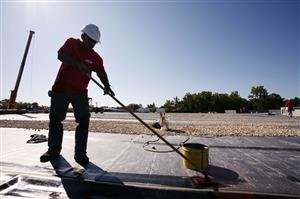 Modified Bitumen (MB) is asphalt that has had modifiers added to it to give it plastic or rubber-like properties. The most common types of modifiers being used are APP (Atactic Polypropylene) and SBS (Styrene Butadiene Styrene).
Modified Bitumen (MB) is asphalt that has had modifiers added to it to give it plastic or rubber-like properties. The most common types of modifiers being used are APP (Atactic Polypropylene) and SBS (Styrene Butadiene Styrene).
Rolls of modified bitumen membrane come in widths of 36″ (0.9 m) to approximately 39″ (1 m) and cover an area of approximately 100 square feet to 112 square feet per roll. Surfacings for these roll materials consist of a smooth surface, or mineral granules, aluminum, copper, or an aggregate such as gravel or slag that is set it hot asphalt.
Modified Bitumen roof systems consist of one, two, or three ply systems. The type of substrate will often determine the type of system being installed. Modified membranes can also be installed in conjunction with built-up roof materials (such as multiple plies of fiberglass felt) to form a “hybrid” roof system. Modifieds have proven performance on residential, commercial, and industrial applications.
![]()
Built up Asphalt
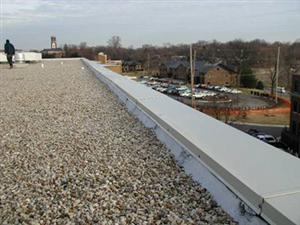 Each ply of a Built-Up Roofing system contains a mat of glass fiber reinforcement – most single-ply systems contain no reinforcement at all. When multiple plies are combined and sandwiched between layers of water-resistant asphalt, the result is a longer lasting roof.
Each ply of a Built-Up Roofing system contains a mat of glass fiber reinforcement – most single-ply systems contain no reinforcement at all. When multiple plies are combined and sandwiched between layers of water-resistant asphalt, the result is a longer lasting roof.
All roofs expand and contract. Single-ply roofs respond with elongation. But over time these systems can lose their elasticity, resulting in buckling, ridges and splits. A Built-Up Roof, however, limits movement with a high tensile strength in excess of the recommended 200 lbs./sq.in. The potential for fracturing is more or less eliminated, and the Built-Up Roof will last longer.
![]()
Coal Tar Pitch
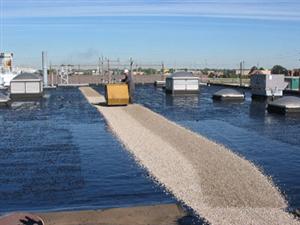 The traditional coal tar system is a built up roof that is manufactured on site, with layers of felts adhered to the roof using hot-applied coal tar pitch. It is the coal tar that protects the roof from the elements, while the felts act as reinforcement. Simple though this sounds, the impregnability of coal tar, even in this basic configuration, ensures lasting protection against the elements.
The traditional coal tar system is a built up roof that is manufactured on site, with layers of felts adhered to the roof using hot-applied coal tar pitch. It is the coal tar that protects the roof from the elements, while the felts act as reinforcement. Simple though this sounds, the impregnability of coal tar, even in this basic configuration, ensures lasting protection against the elements.
Coal tar’s molecular structure provides the extraordinary benefit of actually healing itself as it begins, like all organics, to succumb to natural degradation. Specifically, any cracks that might be formed by impact or rapid drops in temperature, reseal when surface temperatures rise and the coal tar softens. These self-healing properties provide a long-term roofing solution that will require less maintenance than most roofing systems.
To counteract its low softening point, coal tar roofing requires surfacing with gravel, which provides a durable surface for roof traffic. Coal tar’s unique chemical properties allow it to remain insoluble in water, explaining why many coal tar roofs are preferred for roofs with ponding water. Unlike most roofing materials, coal tar shows good resistance to attack from most organic compounds. Hydrocarbons, gasoline vapors, exhaust fumes, and cooking oils and fats do not affect coal tar, making it ideal for applications that require some chemical resistance. Attributes such as these have made coal tar roofing a long-term solution for flat and low-slope roofs for decades.
![]()
Slate
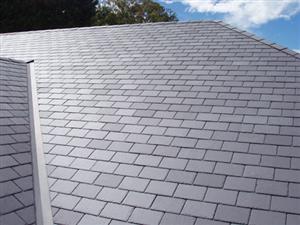 Slate is a fine-grained, homogeneous, sedimentary rock composed of clay or volcanic ash which has been metamorphosed in layers. Slate can be made into roofing slates, because it has two lines of breakability: cleavage and grain. This makes it possible to split slate into thin sheets. Fine slate can also be used to hone knives.
Slate is a fine-grained, homogeneous, sedimentary rock composed of clay or volcanic ash which has been metamorphosed in layers. Slate can be made into roofing slates, because it has two lines of breakability: cleavage and grain. This makes it possible to split slate into thin sheets. Fine slate can also be used to hone knives.
Slate is mainly composed of quartz and muscovite (a mica), often along with biotite, chlorite, and hematite, or, less frequently, apatite, graphite, kaolin, magnetite, tourmaline, or zircon.
Some of the finest slates in the world come from Portugal, Wales in the United Kingdom, the east coast of Newfoundland, and the “Slate Valley” of Vermont and New York.



